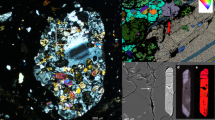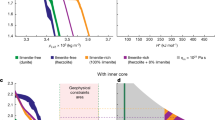Abstract
The evolution and internal structure of Mars are, by comparison to its present-day surface, poorly known—although evidence of recent volcanic activity1 suggests that its deep interior remains hot and convectively cooling. The cooling rate of Mars is related to its early thermal state and to its rheology, which determines its ability to deform and to dynamically evolve2. Attempts to reconstruct the dynamic history of Mars and reveal its present-day structure, by combining the study of thermal evolution with surface observations, are limited by the interplay between several key quantities—including temperature, composition and rheology. Here we show that by considering Phobos (the closest satellite of Mars)—the orbital evolution of which is governed by the thermochemical history of Mars, through tidal interactions—we can gain insight into the thermal history and rheology of the planet. We investigated the long-term evolution of the main envelopes of Mars; these comprise a liquid metallic core that is overlain by a homogeneous silicate convecting mantle underneath an evolving heterogeneous lithospheric lid that includes a crust enriched in radiogenic elements. By exploiting the relationship between Mars and Phobos within an established in situ scenario for the early origin of the moons of Mars3, we find that—initially—Mars was moderately hotter (100 to 200 kelvin) than it is today, and that its mantle sluggishly deforms in the dislocation creep regime. This corresponds to a reference viscosity of 1022.2 ± 0.5 pascal seconds and to a moderate to relatively weak intrinsic sensitivity of viscosity to temperature and pressure. Our approach predicts a present-day average crustal thickness of 40 ± 25 kilometres and a surface heat flow of 20 ± 1 milliwatts per square metre. We show that combining these predictions with data from future and ongoing space missions—such as InSight—could reduce uncertainties in Martian thermal and rheological histories, and help to uncover the origin of Phobos.
This is a preview of subscription content, access via your institution
Access options
Access Nature and 54 other Nature Portfolio journals
Get Nature+, our best-value online-access subscription
$29.99 / 30 days
cancel any time
Subscribe to this journal
Receive 51 print issues and online access
$199.00 per year
only $3.90 per issue
Buy this article
- Purchase on Springer Link
- Instant access to full article PDF
Prices may be subject to local taxes which are calculated during checkout



Similar content being viewed by others
Data availability
The data that support the findings of this study are available from the corresponding author on request.
Code availability
The code for computing the thermal and orbital evolutions is available on request from the corresponding author.
References
Hartmann, W. K. et al. Evidence for recent volcanism on Mars from crater counts. Nature 397, 586–589 (1999).
Schubert, G., Turcotte, D. & Olson, P. Mantle Convection in the Earth and Planets (Cambridge Univ. Press, Cambridge, 2001).
Rosenblatt, P. et al. Accretion of Phobos and Deimos in an extended debris disc stirred by transient moons. Nat. Geosci. 9, 581–583 (2016).
Karato, S.-I. Deformation of Earth Materials: An Introduction to the Rheology of Solid Earth (Cambridge Univ. Press, Cambridge, 2008).
Hauck, S. A. II & Phillips, R. J. Thermal and crustal evolution of Mars. J. Geophys. Res. 107, 6-1–6-9 (2002).
Grott, M. & Breuer, D. The evolution of the martian elastic lithosphere and implications for crustal and mantle rheology. Icarus 193, 503–515 (2008).
Mitrovica, J. X. Haskell [1935] revisited. J. Geophys. Res. 101, 555–569 (1996).
Cordier, P., Amodeo, J. & Carrez, P. Modelling the rheology of MgO under Earth’s mantle pressure, temperature and strain rates. Nature 481, 177–180 (2012).
Raterron, P. et al. Multiscale modeling of upper mantle plasticity: from single-crystal rheology to multiphase aggregate deformation. Phys. Earth. Pl. Int. 228, 232–243 (2014).
Girard, J., Chen, J., Raterron, P. & Holyoke, C. W. Hydrolytic weakening of olivine at mantle pressure: evidence of [1 0 0](0 1 0) slip system softening from single-crystal deformation experiments. Phys. Earth. Pl. Int. 216, 12–20 (2013).
Treiman, A. H., Gleason, J. D. & Bogard, D. The SNC meteorites are from Mars. Planet. Space Sci. 48, 1213–1230 (2000).
Kaula, W. M. Tidal dissipation by solid friction and the resulting orbital evolution. Rev. Geophys. Space Phys. 2, 661–685 (1964).
Jackson, I., Fitz Gerald, J. D., Faul, U. H. & Tan, B. H. Grain-size-sensitive seismic wave attenuation in polycrystalline olivine. J. Geophys. Res. 107, ECV5-1–ECV5-16 (2002).
Rosenblatt, P. The origin of the Martian moons revisited. Astron. Astrophys. Rev. 19, 44 (2011).
Black, B. A. & Mittal, T. The demise of Phobos and development of a Martian ring system. Nat. Geosci. 8, 913–917 (2015).
Peale, S. J. Origin and evolution of the natural satellites. Annu. Rev. Astron. Astrophys. 37, 533–602 (1999).
Mignard, F. Evolution of the Martian satellites. Mon. Not. R. Astron. Soc. 194, 365–379 (1981).
Burns, J. A. in Mars (eds Kieffer, H. H. et al.) 1283–1301 (Univ. of Arizona Press, Tucson, 1992).
Szeto, A. M. K. Orbital evolution and origin of the Martian satellites. Icarus 55, 133–168 (1983).
Hesselbrock, A. J. & Minton, D. A. An ongoing satellite–ring cycle of Mars and the origins of Phobos and Deimos. Nat. Geosci. 10, 266–269 (2017).
Hyodo, R., Genda, H., Charnoz, S. & Rosenblatt, P. On the impact origin of Phobos and Deimos. I. Thermodynamic and physical aspects. Astrophys. J. 845, 125 (2017).
Baratoux, D., Toplis, M., Monnereau, M. & Gasnault, O. Thermal history of Mars inferred from orbital geochemistry of volcanic provinces. Nature 472, 338–341 (2011).
Connerney, J. E. P. et al. Mars crustal magnetism. Sol. Syst. Res. 11, 1–32 (2004).
Zharkov, V. N. & Gudkova, T. V. Construction of Martian interior model. Sol. Syst. Res. 39, 343–373 (2005).
Konopliv, A. S., Park, R. S. & Folkner, W. M. An improved JPL Mars gravity field and orientation from Mars orbiter and lander tracking data. Icarus 274, 253–260 (2016).
Lognonné, P. & Mosser, B. Planetary seismology. Surv. Geophys. 14, 239–302 (1993).
Breuer, D. & Spohn, T. Early plate tectonics versus single-plate tectonics on Mars: evidence from magnetic field history and crust evolution. J. Geophys. Res. 108, 8-1–8-13 (2003).
Christensen, U. R. Convection in a variable-viscosity fluid: Newtonian versus power-law rheology. Earth Planet. Sci. Lett. 64, 153–162 (1983).
Kiefer, W. S. & Li, Q. Water undersaturated mantle plume volcanism on present-day Mars. Meteorit. Planet. Sci. 51, 1993–2010 (2016).
Thiriet, M., Michaut, C., Breuer, D. & Plesa, A.-C. Hemispheric dichotomy in lithosphere thickness on Mars caused by differences in crustal structure and composition. J. Geophys. Res. Planets 123, 823–848 (2018).
Maurice, M. et al. Onset of solid-state mantle convection and mixing during magma ocean solidification. J. Geophys. Res. Planets 122, 577–598 (2017).
Lognonné, P. et al. SEIS: the seismic experiment for internal structure of InSight. Space Sci. Rev. 215, 12 (2019).
Spohn, T. et al. The heat flow and physical properties package (HP3) for the InSight mission. Space Sci. Rev. 214, 96 (2018).
Acknowledgements
The authors thank S. Charnoz, A. Mocquet, and M. Thiriet for fruitful discussions; and M. Thiriet for providing data for the benchmark comparison (Supplementary Fig. 2). The software for the computation of the elastic Love number was provided by J. Wahr. Numerical computations were performed on the S-CAPAD platform (IPGP, France). V.L.’s research was supported by an appointment to the NASA Postdoctoral Program at the NASA Jet Propulsion Laboratory, California Institute of Technology, administered by Universities Space Research Association under contract with NASA. P.L. and M.P. thank CIDER (NSF EAR-1135452) for providing the 2014 summer school environment at KITP UCSB during which an early version of this research was imagined and discussed. Figures were made using the Generic Mapping Tools (P. Wessel and W. H. F. Smith (EOS, Trans. AGU 76 (1995) 329)). This is IPGP contribution number 4026 and InSight contribution number 76.
Author information
Authors and Affiliations
Contributions
P.L. proposed the original idea. M.P. contributed to the original idea development. P.L. developed and tested the software for the computation of the Love number imaginary part. V.L. and H.S. developed and discussed the orbital evolution model. H.S. developed the thermo-chemical evolution and the seismic models, implemented the computer code for the coupled thermo-chemical and orbital evolution, performed the simulations and data analysis, produced the figures and wrote the paper. All authors discussed the paper and interpreted the results.
Corresponding author
Ethics declarations
Competing interests
The authors declare no competing interests.
Additional information
Publisher’s note: Springer Nature remains neutral with regard to jurisdictional claims in published maps and institutional affiliations.
Supplementary information
Supplementary Information
This file contains 6 Text sections and including 36 equations, 2 paragraphs statements (code and data availability), 9 Figures + captions, 3 Tables and 60 References.
Rights and permissions
About this article
Cite this article
Samuel, H., Lognonné, P., Panning, M. et al. The rheology and thermal history of Mars revealed by the orbital evolution of Phobos. Nature 569, 523–527 (2019). https://doi.org/10.1038/s41586-019-1202-7
Received:
Accepted:
Published:
Issue Date:
DOI: https://doi.org/10.1038/s41586-019-1202-7
This article is cited by
-
Geophysical evidence for an enriched molten silicate layer above Mars’s core
Nature (2023)
-
Single-camera PTV within interfacially sheared drops in microgravity
Experiments in Fluids (2023)
-
Amyloidogenesis via interfacial shear in a containerless biochemical reactor aboard the International Space Station
npj Microgravity (2022)
-
Geophysical evidence for an active mantle plume underneath Elysium Planitia on Mars
Nature Astronomy (2022)
-
Dynamical evidence for Phobos and Deimos as remnants of a disrupted common progenitor
Nature Astronomy (2021)
Comments
By submitting a comment you agree to abide by our Terms and Community Guidelines. If you find something abusive or that does not comply with our terms or guidelines please flag it as inappropriate.



